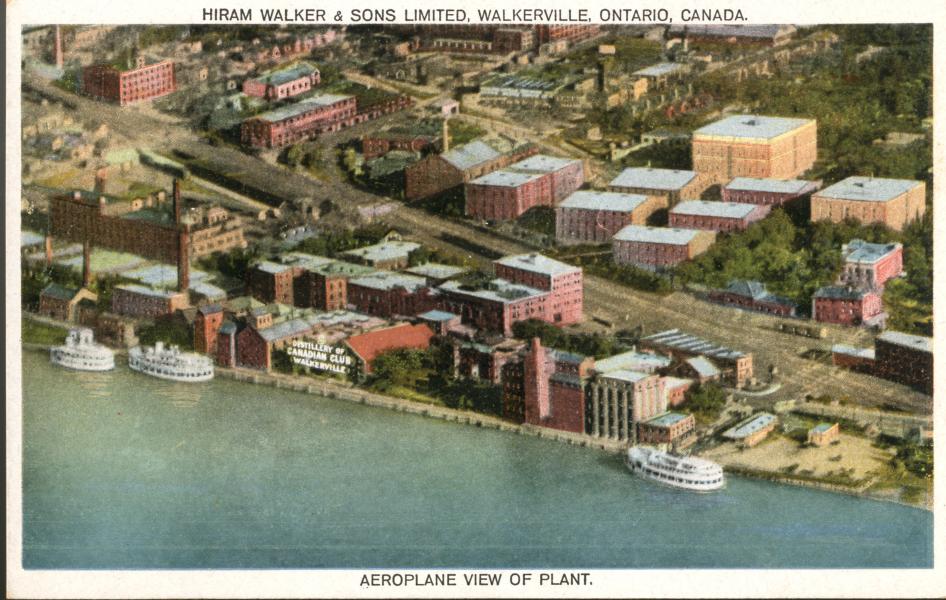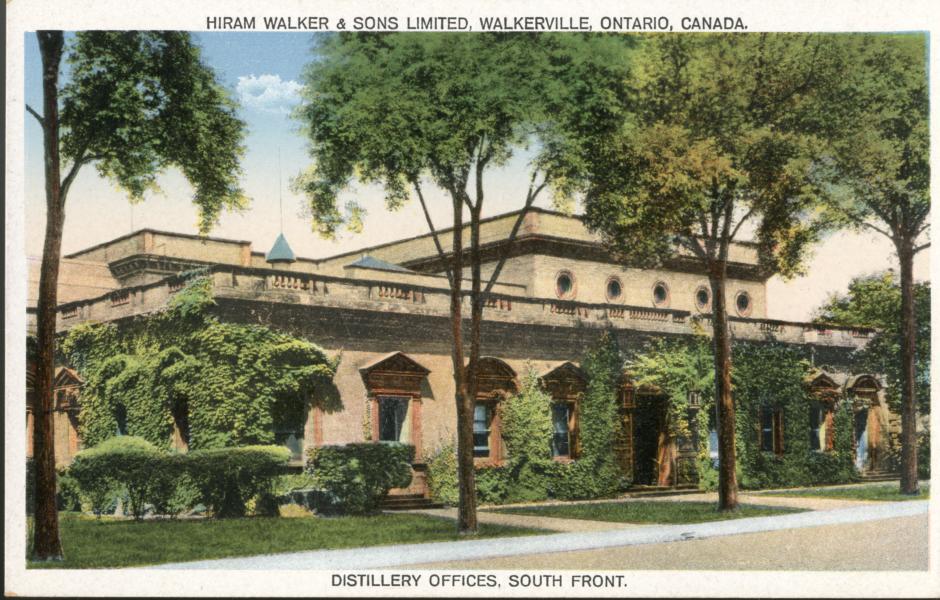A History of Hiram Walker and Walkerville

In 1856 Hiram Walker, a former Detroit grocer and cider vinegar distiller by way of Massachusetts, began the purchase of what would amount to 468 acres of land east of Windsor; land which was thought to once be settled by the famous Chief Pontiac and the Ottawa Indians. He planned to move and expand his small whisky operation from Detroit to Canada, with an initial investment of $40,000 which also built the distillery, a steam-powered flour mill, and a hog and cattle farm.
The success of his visionary business ventures happened quickly, and by 1870 Walkerville attains village status in Ontario while “Hiram Walker’s” becomes the largest distillery in the new Confederation of Canada. Hiram was one of the first distillers to sell his whiskey in branded barrels, and his Walker’s Club Whisky was renowned for its singular quality and purity. It was at the insistence of his U.S. competitors that he was first forced to add the word "Canadian" to his label, a move that stands to this day as the iconic Canadian Club®.
In 1880 Hiram Walker leased the ferry “Essex” and built docking facilities at the foot of Walker Street in Detroit and at his distillery in Canada, to allow him to commute from Detroit to work each day by boat. The “Walkerville and Detroit Ferry Company” he founded remained in operation until 1942. In 1882 Walker built a rail line to connect Walkerville with his farm land in Essex county, and only 2 years later expanded to link with Kingsville (where he built the elegant Mettawas Hotel – the stone Kingsville Rail Station still remains), Leamington, London and Port Stanley, with many town stops along the way. By 1888 Hiram expanded fully to the Lake Erie and Detroit River Railway.
The town of Walkerville wasn’t incorporated until 1890, but was already a bustling "model town" design conceived by Hiram Walker himself. He was sure to provide many town amenities that even larger cities lacked at the time, such as running water, police and fire service, paved and drained streets, street lights, and even one of the first streetcar systems in Canada, all at his own expense. As a model town, Walkerville was designed with treed boulevards, a grid layout, and beautiful homes. Many heritage homes and buildings remain today, including stately Willistead Manor, a living showcase to the architectural design genius of the famed Albert Kahn of Detroit. Kahn was also involved in the design of many of the commercial buildings still in existence here, as well as the townhomes that Hiram Walker constructed for his factory workers which can be seen along Monmouth Road.
In August of 1904 a new economic era was borne of Walkerville as Gordon McGregor founded the Ford Motor Company of Canada from its beginnings as his father’s Walkerville Wagon Works. Located on lands just east of the booming Walkerville, Ford City grew as a strong neighbour. With Chrysler Canada and General Motors following quickly to begin operations on Walker-owned lands to the south, this region took its’ first steps to becoming the automotive capital of Canada. This included even the first Canadian assembly plant for motorized fire trucks, a Seagrave plant which opened on Walker Road around 1905. The birth of the auto industry in Canada happened right here in and around Walkerville, and is due largely to the excellent infrastructure built by and for Hiram Walker’s own various companies.
A new cottage industry was born in 1918 in Walkerville and Windsor when Detroit was the first major U.S. city to enforce Prohibition. The Detroit River couldn’t have been a better smuggling highway – less than a mile across in some spots, and with hundreds of small coves – it was described as a "smugglers' paradise." Historians have estimated that up to 75% of all illegal liquor supplied to thirsty Americans passed through our waterways. The original rumrunners were mostly ordinary folk, running liquor across the border. However gangsters soon took charge of this lucrative enterprise, and organized crime took over the "business." The infamous Purple Gang, linked with Al Capone's Chicago syndicate, was notorious across North America for their ruthless reputation and by the late 1920’s they had control of the Detroit underworld. Al Capone and his representative were said to frequent Walkerville during that time, but when Prohibition was finally repealed in 1933 Walkerville and Windsor resumed their peaceful and law-abiding ways.
By 1926 the remaining Walker family owning and operating Hiram Walker and Sons Ltd sold the company for $14 million to Harry C. Hatch of Toronto, and incredibly Hiram Walker remains North America’s largest beverage distillery to this day. Although Walkerville was forcibly amalgamated in 1935 with Windsor (against the vote of its residents at the time), the growth and success of this neighbourhood and commercial district made it a permanent living history of the vision for the thriving town it remains.
There is a seemingly endless list of other assets and developments in the region not mentioned above, which were in some way touched by Hiram Walker and his family, all with their own incredible stories. Here are just a few:
- The Windsor Airport, formerly Walkerville Airport
- Windsor Regional Metropolitan Hospital
- St. Mary’s Anglican Church
- The original Essex Golf Club (located where Walkerville Collegiate is now)
- King Edward Elementary School (originally at the foot of Wyandotte and Devonshire)
- Walkerville Collegiate Institute
- Walkerville Technical Institute (later W.D. Lowe)
- Belle Isle canals, bridges and cottage (the footings can still be seen)
- The Children’s Hospital of Michigan
- The Detroit Art Museum
- Ownership of the Gooderham Woorts brewery (now the Toronto Distillery District)
Hiram Walker himself is declared a person of Canadian National Historic Significance, and recently the City of Windsor Council declared Hiram Walker’s birthday (July 4th) to be Hiram Walker Day, a declaration of the original Towne of Walkerville prior to amalgamation. Walkerville today stands host to the largest collection of heritage structures (residential and commercial) in Essex County. See the Walking Tour for an information listing of some of those buildings.
